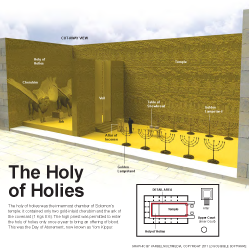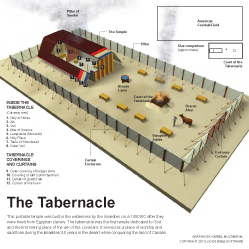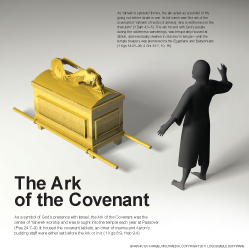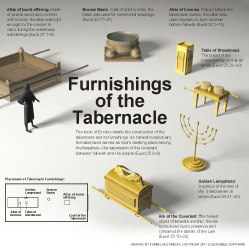9:1–10 In this section, the author focuses on provisions within the tabernacle. After describing the various objects associated with the priesthood (vv. 2–5), the author continues by describing the regulation and practice of religious life (vv. 6–10). The infrequency of access to God under the old covenant serves to demonstrate that such an arrangement could function only provisionally (vv. 7–8). Furthermore, the sacrifices’ failure to properly cleanse indicates the need for a more effective sacrifice (vv. 9–10). This description of the tabernacle leads into 9:11–10:18, which discusses Christ’s priestly ministry within the heavenly sanctuary. |
9:1 first covenant Refers to the Mosaic covenant. The word prōtos, meaning “first,” was also used in 8:13 and links the two sections.
The word prōtos, meaning “first,” was also used in 8:13 and links the two sections.
regulations for worship Refers broadly to the design, contents, and actions associated with Israel’s tabernacle. Worship refers to acceptable priestly service (vv. 6–7; Num 16:9; 1 Chr 28:13) and adherence to God’s commands (Exod 20:5; 23:24; Deut 10:12).
earthly sanctuary This description of the sanctuary refers more to its composition than location, and it contrasts the true tabernacle (Heb 8:2) that consists of heavenly things (8:5).
9:2 lampstand Located at the south side of the holy place (Exod 26:35), the lampstand was crafted of hammered gold (Exod 25:31). It included three branches on each side that resembled almond blossoms (Exod 25:33). God had commanded Aaron and his sons to burn oil in this lamp perpetually (Exod 27:20–21; Lev 24:2–3).
table Stood at the north side of the holy place (Exod 26:35). The table was made of acacia wood and overlaid with gold (Exod 25:23–24). It held various religious objects, including dishes for incense and bowls for drink offerings (Exod 25:29–30).
presentation of the loaves These loaves were arranged in two rows and placed upon the table each Sabbath (Exod 40:23; Lev 24:6; 29; 1 Chr 9:32).
9:3 second curtain There were three curtains or veils in the tabernacle complex (Exod 26:31–35; 27:16). The one indicated here separated the holy place (where priests performed their regular ministry) from the most holy place. Only the high priest was allowed beyond this curtain, and only once a year on the Day of Atonement
Only the high priest was allowed beyond this curtain, and only once a year on the Day of Atonement (Lev 16:2).
(Lev 16:2).
The curtain was made of fine blue linen and had two cherubim embroidered on it (Exod 26:31). This image of the cherubim served as a warning for people to keep out, due to their depiction in the ot as supernatural guardians who protect sacred space (Gen 3:24). The reality of God’s presence required a physical barrier, to keep priests from inadvertently crossing into it.
holy of holies The place of God’s presence. The holy of holies contained an incense altar and the ark of the covenant (see vv. 4; Exod 25:10; 26:33; 40:3). The Greek expression is superlative, emphasizing that this inner sanctuary was the most holy of all holy places.
contained an incense altar and the ark of the covenant (see vv. 4; Exod 25:10; 26:33; 40:3). The Greek expression is superlative, emphasizing that this inner sanctuary was the most holy of all holy places.
9:4 golden incense altar On the Day of Atonement, priests sprinkled blood from the sin offering upon the horns of this incense altar and upon the mercy seat (Exod 30:10; Lev 16:15; compare Isa 52:15 and note).
ark of the covenant Located in the most holy place, the ark was made of acacia wood and overlaid with gold (Exod 25:10–15; 37:1–5). The ark mediated God’s presence to the people (Exod 25:22). The Israelites carried the ark using two long poles, so that no one would touch the ark itself and die.
was made of acacia wood and overlaid with gold (Exod 25:10–15; 37:1–5). The ark mediated God’s presence to the people (Exod 25:22). The Israelites carried the ark using two long poles, so that no one would touch the ark itself and die.
golden jar Moses instructed Aaron to collect some manna—the bread God gave the Israelites in the wilderness—and place it in a jar before the Lord (Exod 16:33–34).
rod of Aaron Refers to Aaron’s staff that miraculously blossomed, demonstrating that God called Aaron and his sons to the ministry of the priesthood (Num 17:1–11).
tablets Moses received the stone tablets with God’s law written on them (Deut 9:9–10). The Israelites placed these tablets within the ark (Deut 10:1–5).
9:5 cherubim of glory Refers to two winged, angelic creatures made of gold (Exod 25:18–22). From either side of the ark, the cherubim overshadowed the mercy seat, where God was enthroned (1 Sam 4:4; 2 Sam 6:2; Isa 37:16).
mercy seat The Greek term used here, hilastērion, refers to the golden lid of the ark. This lid was considered the earthly counterpart to the throne of grace (Heb 4:16). On the Day of Atonement, the divine presence appeared in a cloud over the lid (Lev 16:13–17). Moses (and later the priesthood) met with God there (Exod 25:22; Num 7:89).
9:6 into the first tent continually Priests entered the first tent regularly to carry out their priestly duties (see Heb 9:2), such as ensuring the lampstand was functioning and cared for (Exod 27:20–21), replacing the bread of the Presence (Lev 24:8–9), and sacrificing two lambs daily (Exod 29:38–42). The detail that the priests could enter continually (dia pantos in Greek) highlights the perpetual and ongoing nature of the sacrifices.
9:7 into the second tent once In contrast to the constant service of the priests in the first tent (Heb 9:6), the high priest was permitted to enter the second tent only once a year, on the Day of Atonement.
not without blood The high priest could not enter the holy of holies (most holy place) without offering a blood sacrifice—a bull offered on behalf of himself and his household (Lev 16:11). After slaughtering the animal outside, the blood would be brought inside and sprinkled upon the mercy seat, the lid of the ark (Lev 16:14).
9:8 Holy Spirit was making this clear The Holy Spirit provides special revelation for understanding the true purpose and provision of the sacrificial system.
9:9 symbol The author describes the first tent—not the entire tabernacle infrastructure—as a symbol that points beyond itself.
present time In this era, believers have already experienced powers of the coming age (6:5), but they are yet to enter God’s rest (see 4:9–10).
perfect the worshiper with respect to the conscience See 7:11 and note. Defilement caused by sin extends to the conscience. The first covenant was unable to produce true sanctification and peace (7:18–19; 10:1–4) because guilt offerings and offerings for unknown sins had to be made continually. The new covenant purifies the conscience (vv. 14; 10:22) and provides assurance to believers; Jesus’ offering is once for all (7:27).
9:10 food and drink Refers to ot practices regarding clean and unclean foods (see Lev 11; Deut 14:1–21).
different washings Priests were required to cleanse themselves (Exod 29:4; Lev 8:6; 16:4).
time of setting things right Refers to the era of the new covenant (Heb 9:26).
9:11–28 In this section, the author focuses on Christ’s death (which secures redemption; vv. 11–14), Christ’s mediation of the new covenant (vv. 15–22), and the perfection of Christ’s sacrifice (vv. 23–28). |
9:11 Christ has arrived as a high priest Refers to His entrance into the heavenly tabernacle by means of His death (v. 28).
good things to come Refers to the aspects of redemption available through the new covenant. These include purification of the conscience (v. 14), receipt of an eternal inheritance (v. 15), the putting away of sin (vv. 26, 28), and unrestricted access to God (v. 24).
9:12 blood of goats and calves The author of Hebrews relies on the ot for the religious metaphors used to illustrate Jesus’ sacrificial death. Three sacrifices were associated with the offering on the Day of Atonement: a bull and two goats. The priest offered the bull on behalf of himself and his family (Lev 16:6, 11). One goat was presented alive as the scapegoat. The Israelites would then release the scapegoat into the wilderness in order to take away sins from Israel (Lev 16:10). The second goat would be slaughtered for a sin offering (Lev 16:15).
his own blood Refers to Jesus’ blood in the sacrificial sense—His life poured out in death.
eternal redemption Secured because Christ’s sacrifice was once for all.
9:13 ashes of a young cow Refers to the red heifer (see note on Num 19:1–22). Although this sacrifice is not associated with the Day of Atonement, it is related to the idea of external ritual purity.
9:14 eternal Spirit The Greek phrase used here, pneumatos aiōniou, most likely refers to the Holy Spirit, as do most other references to “spirit” (pneuma in Greek) in the singular in Hebrews (e.g., Heb 2:4; 6:4; 9:8, 14). The phrase also could refer to Jesus’ spirit or divinity.
cleanse our consciences The Greek term used here, syneidēsis, refers to an inward aptitude for distinguishing right and wrong (see Rom 2:15; 9:1; 1 Cor 10:29; 2 Cor 1:12; 4:2; 5:11; Heb 10:22; 13:18). The sacrifices of the old covenant only cleansed the flesh (v. 13). Christ’s sacrifice, however, cleanses the conscience as well. This coheres with the new covenant promise that God forgives sins and writes His law on the hearts of His people (see 8:10–12; Jer 31:31–34).
dead works Describes acts that defile a person and create separation from God (Heb 6:1).
9:15 mediator of a new covenant Because Jesus offered Himself as a sacrifice, He is the mediator of the new covenant (see 8:6; 12:24; 1 Tim 2:5; compare Isa 53:6, 12). As such, Christ intercedes on behalf of humanity before God. He is uniquely qualified to do so because of His incarnation (Heb 2:14–18) and appointment as high priest (5:5–6).
those who are the called The Greek terminology here refers to Christians, who share in a heavenly calling (3:1). Jesus mediates on our behalf so that we may receive an eternal inheritance.
promise of the eternal inheritance Salvation in the world to come (Heb 1:14; 2:5).
9:16 a will The Greek term used here, diathēkē, was a general word for various kinds of legal contracts. The author uses this same word throughout vv. 15–20 but invokes the sense of diathēkē as a last will and testament in vv. 16–17. Ultimately, the author is alluding to the broken Sinai covenant, which brought a curse of death on those who did not keep it (2:2; 10:28). The analogy with a last will and testament explains how Christ’s death brought this new covenant into effect. Compare 2:9, 14; 9:15, 28, Heb 9:28; 10:15–17; 12:24.
the death Connects two concepts of the Greek word diathēkē (legal contract versus last will and testament). Just as a will goes into effect when a person dies, the procedures for making a legally binding contract sometimes involved the representative death of a sacrificial animal (Jer 34:18).
9:18–21 This passage summarizes the enactment of the first covenant at Sinai (Exod 24:3–8), with an emphasis on the relationship between the covenant and blood. |
9:18 ratified Recalls the first covenant within Exodus, which was “inaugurated” (enkainizō, “to inaugurate”)—or put into effect—with blood (Exod 24:6, 8).
9:19 when every commandment Refers to the words of the law that God spoke to Moses (Exod 24:4).
water and scarlet wool and hyssop These details do not appear in the Exod 24 account, but they do appear in other passages about sacrifices (Exod 12:22; Lev 14:4–7; Num 19:6, 18).
sprinkled The sprinkling of blood enacted ritual purity (Exod 24:8).
the scroll The act of sprinkling blood on the scroll is not attested elsewhere in the Bible.
9:21 And likewise This Greek terminology might be indicating that the verse describes another event (see Exod 29:12; Lev 8:15,23–24). Exodus 24 does not include the details provided here.
9:22 purified with blood In accordance with the ot, blood was required for purification; it was understood to remove defilement.
there is no forgiveness The Greek word used here, aphesis, denotes the remission of sins (see Heb 10:4, 18). Forgiveness was not possible without “the shedding of blood” (haimatekchysia), which refers to the offering of blood at an altar.
9:23 sketches of the things in heaven See 8:2 and note.
heavenly things The earthly tabernacle required sacrifices, so the true tent required a better sacrifice—the blood of Jesus.
9:24 a sanctuary made by hands Refers to the tabernacle or temple built by God’s servants. See note on Heb 9:1.
on our behalf Jesus mediates (8:6; 9:15; 12:24) and intercedes (7:25; compare 2:18; 4:15) on behalf of believers. He also sacrificed Himself for believers (v. 26; compare Exod 23:15, 17; 34:23; Deut 16:16).
9:25 blood not his own The Levitical priests were allowed to enter the holy of holies (most holy place) on the Day of Atonement by means of the sacrificial blood of bulls and goats (see Lev 16:14–16; Heb 9:12–13).
(most holy place) on the Day of Atonement by means of the sacrificial blood of bulls and goats (see Lev 16:14–16; Heb 9:12–13).
9:26 end of the ages Signaled by Christ’s appearance.
removal of sin Refers to Jesus’ death as an atoning sacrifice (Heb 2:17). Jesus appeared so that He might remove sins (see 1 John 3:5). He made purification and bore the sins of His people (Heb 1:3; 9:28; compare Isa 53:12).
9:27 judgment No one can escape judgment (Heb 4:12–13; 9:27; 10:30) because God is the judge of all things (see Isa 33:22). Resurrection and final judgment are also associated in Heb 6:1–2.
9:28 bear the sins of many Refers to Jesus’ life and death on behalf of believers, referencing to Isa 53:12.
appear for the second time When Christ returns, He will fully establish the kingdom of God—a work that has already begun—and dethrone the authorities and powers of this world (1 Cor 15:23–26).
those who eagerly await That is, believers (see Phil 3:20).

|
About Faithlife Study BibleFaithlife Study Bible (FSB) is your guide to the ancient world of the Old and New Testaments, with study notes and articles that draw from a wide range of academic research. FSB helps you learn how to think about interpretation methods and issues so that you can gain a deeper understanding of the text. |
| Copyright |
Copyright 2012 Logos Bible Software. |
| Support Info | fsb |
 Loading…
Loading…





